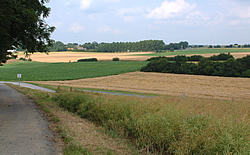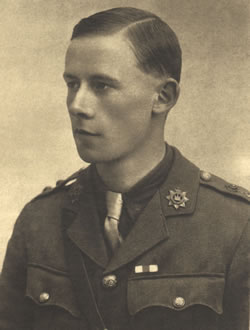As The 100th
Anniversary Of The First Year Of World War I (Remember The War To End All Wars)
Continues ... Some Remembrances-Poet’s Corner
Before Action
by Lieutenant William Noel Hodgson, MC, 29th June, 1916
 |
By all the glories of the day
And the cool evening's benison
By that last sunset touch that lay
Upon the hills when day was done,
By beauty lavishly outpoured
And blessings carelessly received,
By all the days that I have lived
Make me a soldier, Lord.
And the cool evening's benison
By that last sunset touch that lay
Upon the hills when day was done,
By beauty lavishly outpoured
And blessings carelessly received,
By all the days that I have lived
Make me a soldier, Lord.
By all of all man's hopes and fears
And all the wonders poets sing,
The laughter of unclouded years,
And every sad and lovely thing;
By the romantic ages stored
With high endeavour that was his,
By all his mad catastrophes
Make me a man, O Lord.
And all the wonders poets sing,
The laughter of unclouded years,
And every sad and lovely thing;
By the romantic ages stored
With high endeavour that was his,
By all his mad catastrophes
Make me a man, O Lord.
I, that on my familiar hill
Saw with uncomprehending eyes
A hundred of thy sunsets spill
Their fresh and sanguine sacrifice,
Ere the sun swings his noonday sword
Must say good-bye to all of this; -
By all delights that I shall miss,
Help me to die, O Lord.
Saw with uncomprehending eyes
A hundred of thy sunsets spill
Their fresh and sanguine sacrifice,
Ere the sun swings his noonday sword
Must say good-bye to all of this; -
By all delights that I shall miss,
Help me to die, O Lord.
Inspiration for the Poem
Before Action
 |
It is believed that Noel Hodgson wrote the poem “Before Action” on 29th June.
Into Action
In the early hours of the morning of Saturday 1st July 1916 William Noel Hodgson was in position with his comrades, anxiously waiting for Zero Hour at 07.30 hours. Due to the severe damage from German artillery fire the British Front Line trench was unsuitable for the battalion to assemble in ready for the attack, so the men were about 250 yards behind the British Front Line trench. At Zero Hour the men of 9th Devons advanced from their position behind the Front Line trench, with the 2nd Battalion Border Regiment on their left and the 2ndBattalion the Gordon Highlanders on their right.The 9th Devons had about 400 yards of No-Mans-Land to cross in the Carnoy valley before they could attempt to break into the German Front Line south of Mametz village. As soon as the first men of the Devons reached No-Mans-Land they were exposed to fire from German machine guns. Many were cut down in No-Mans-Land and the battalion suffered heavy casualties. Lieutenant Hodgson was Bombing Officer in the attack. He was responsible for keeping the men supplied with grenades during the attack, which would be especially important if they got into the German positions. Within an hour of the attack it is said that Lieutanant Hodgson was killed. He was aged 23. He would never again see a sunset.
In spite of the heavy casualties lost by the battalion the Devons had progressed with their attack and the German-held village of Mametz was captured by the British 7th Division. All but one of the officers of the 9th Devons were killed or wounded. The British Front Line position did, therefore, successfully advance to a new position by the end of the day.
“The Devonshires Held This Trench”
That night Lieutenant Hodgson's body was retrieved and brought back into the British Front Line position, along with over 160 of his comrades. They were buried in the vicinity of a little wood called Mansell Copse which was in the British Front Line trench position at the start of the day.A ceremony was held at the burial site on 4th July. A wooden cross was put up at the time by the survivors of the 9th and 8th Battalions of the Devonshire Regiment. Carved on the cross were the words: “The Devonshires held this trench, the Devonshires hold it still.” The graves were left in this position when the cemeteries were rebuilt after the war. 163 graves are now contained in the cemetery which is named “Devonshire Cemetery”. All but one of the casualties are men of the Devonshire Regiment. Lieutenant Noel Hodgson is buried in Grave reference A. 3.
Devonshire Cemetery
No comments:
Post a Comment